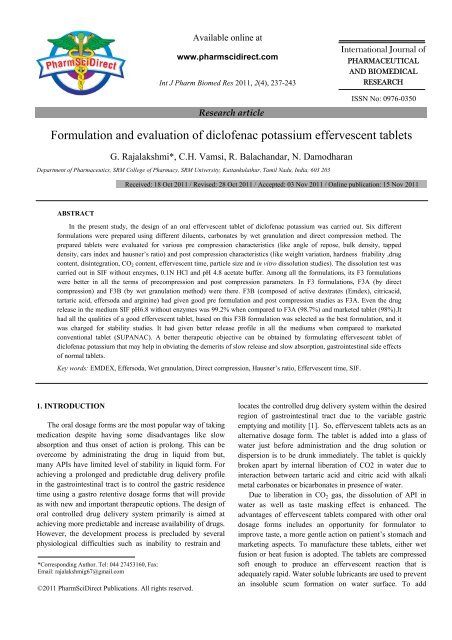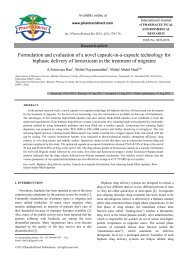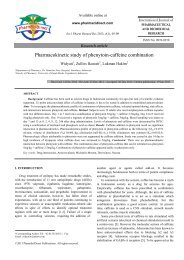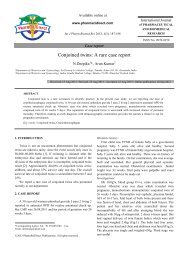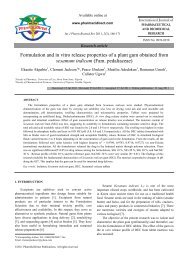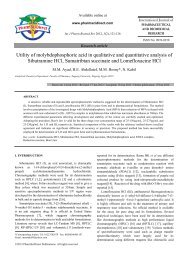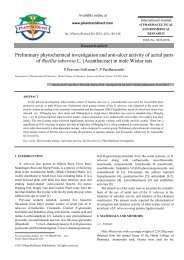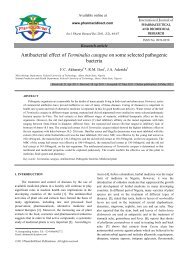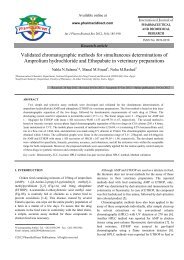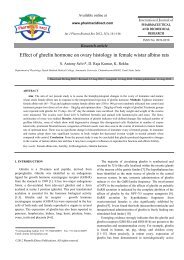Formulation and evaluation of diclofenac ... - PharmSciDirect
Formulation and evaluation of diclofenac ... - PharmSciDirect
Formulation and evaluation of diclofenac ... - PharmSciDirect
Create successful ePaper yourself
Turn your PDF publications into a flip-book with our unique Google optimized e-Paper software.
Available online atwww.pharmscidirect.comInt J Pharm Biomed Res 2011, 2(4), 237-243Research articleInternational Journal <strong>of</strong>PHARMACEUTICALAND BIOMEDICALRESEARCHISSN No: 0976-0350<strong>Formulation</strong> <strong>and</strong> <strong>evaluation</strong> <strong>of</strong> dicl<strong>of</strong>enac potassium effervescent tabletsG. Rajalakshmi*, C.H. Vamsi, R. Balach<strong>and</strong>ar, N. DamodharanDepartment <strong>of</strong> Pharmaceutics, SRM College <strong>of</strong> Pharmacy, SRM University, Kattankulathur, Tamil Nadu, India, 603 203Received: 18 Oct 2011 / Revised: 28 Oct 2011 / Accepted: 03 Nov 2011 / Online publication: 15 Nov 2011ABSTRACTIn the present study, the design <strong>of</strong> an oral effervescent tablet <strong>of</strong> dicl<strong>of</strong>enac potassium was carried out. Six differentformulations were prepared using different diluents, carbonates by wet granulation <strong>and</strong> direct compression method. Theprepared tablets were evaluated for various pre compression characteristics (like angle <strong>of</strong> repose, bulk density, tappeddensity, cars index <strong>and</strong> hausner’s ratio) <strong>and</strong> post compression characteristics (like weight variation, hardness friability ,drugcontent, disintegration, CO 2 content, effervescent time, particle size <strong>and</strong> in vitro dissolution studies). The dissolution test wascarried out in SIF without enzymes, 0.1N HCl <strong>and</strong> pH 4.8 acetate buffer. Among all the formulations, its F3 formulationswere better in all the terms <strong>of</strong> precompression <strong>and</strong> post compression parameters. In F3 formulations, F3A (by directcompression) <strong>and</strong> F3B (by wet granulation method) were there. F3B (composed <strong>of</strong> active dextrates (Emdex), citricacid,tartaric acid, effersoda <strong>and</strong> arginine) had given good pre formulation <strong>and</strong> post compression studies as F3A. Even the drugrelease in the medium SIF pH6.8 without enzymes was 99.2% when compared to F3A (98.7%) <strong>and</strong> marketed tablet (98%).Ithad all the qualities <strong>of</strong> a good effervescent tablet, based on this F3B formulation was selected as the best formulation, <strong>and</strong> itwas charged for stability studies. It had given better release pr<strong>of</strong>ile in all the mediums when compared to marketedconventional tablet (SUPANAC). A better therapeutic objective can be obtained by formulating effervescent tablet <strong>of</strong>dicl<strong>of</strong>enac potassium that may help in obviating the demerits <strong>of</strong> slow release <strong>and</strong> slow absorption, gastrointestinal side effects<strong>of</strong> normal tablets.Key words: EMDEX, Effersoda, Wet granulation, Direct compression, Hausner’s ratio, Effervescent time, SIF.1. INTRODUCTIONThe oral dosage forms are the most popular way <strong>of</strong> takingmedication despite having some disadvantages like slowabsorption <strong>and</strong> thus onset <strong>of</strong> action is prolong. This can beovercome by administrating the drug in liquid from but,many APIs have limited level <strong>of</strong> stability in liquid form. Forachieving a prolonged <strong>and</strong> predictable drug delivery pr<strong>of</strong>ilein the gastrointestinal tract is to control the gastric residencetime using a gastro retentive dosage forms that will provideas with new <strong>and</strong> important therapeutic options. The design <strong>of</strong>oral controlled drug delivery system primarily is aimed atachieving more predictable <strong>and</strong> increase availability <strong>of</strong> drugs.However, the development process is precluded by severalphysiological difficulties such as inability to restrain <strong>and</strong>*Corresponding Author. Tel: 044 27453160, Fax:Email: rajalakshmig67@gmail.com©2011 <strong>PharmSciDirect</strong> Publications. All rights reserved.locates the controlled drug delivery system within the desiredregion <strong>of</strong> gastrointestinal tract due to the variable gastricemptying <strong>and</strong> motility [1]. So, effervescent tablets acts as analternative dosage form. The tablet is added into a glass <strong>of</strong>water just before administration <strong>and</strong> the drug solution ordispersion is to be drunk immediately. The tablet is quicklybroken apart by internal liberation <strong>of</strong> CO2 in water due tointeraction between tartaric acid <strong>and</strong> citric acid with alkalimetal carbonates or bicarbonates in presence <strong>of</strong> water.Due to liberation in CO 2 gas, the dissolution <strong>of</strong> API inwater as well as taste masking effect is enhanced. Theadvantages <strong>of</strong> effervescent tablets compared with other oraldosage forms includes an opportunity for formulator toimprove taste, a more gentle action on patient’s stomach <strong>and</strong>marketing aspects. To manufacture these tablets, either wetfusion or heat fusion is adopted. The tablets are compresseds<strong>of</strong>t enough to produce an effervescent reaction that isadequately rapid. Water soluble lubricants are used to preventan insoluble scum formation on water surface. To add
G. Rajalakshmi et al., Int J Pharm Biomed Res 2011, 2(4), 237-243 238sweetness to the formulation, saccharin is added sincesucrose is hygroscopic <strong>and</strong> add too much <strong>of</strong> bulk to the tablet.The manufacturing shall be done under controlled climaticcondition to avoid effervescent reaction. The packaging isdone under 25% RH at 25ºC. H<strong>and</strong>s <strong>of</strong> the consumers <strong>and</strong>atmospheric moisture after opening the container can alsoresult in loss <strong>of</strong> product quality. The most commonly usedeffervescent tablet today is aspirin tablet [2].In the present study, the design <strong>of</strong> an oral effervescenttablet <strong>of</strong> Dicl<strong>of</strong>enac potassium was carried out. Dicl<strong>of</strong>enacPotassium is a nonsteroidal anti-inflammatory drug (NSAID)that exhibits anti-inflammatory, analgesic, <strong>and</strong> antipyreticactivities. It is used for treatment <strong>of</strong> primary dysmenorrhea,for relief <strong>of</strong> mild to moderate pain, for relief <strong>of</strong> the signs <strong>and</strong>symptoms <strong>of</strong> osteoarthritis <strong>and</strong> rheumatoid arthritis.[Myl<strong>and</strong>rugs.com] The main objective <strong>of</strong> this work was to formulate<strong>and</strong> evaluate Dicl<strong>of</strong>enac potassium effervescent tablets byusing different ratios <strong>of</strong> carbonates <strong>and</strong> acids by wetgranulation <strong>and</strong> direct compression method that helps inobviating the demerits <strong>of</strong> slow release <strong>and</strong> slow absorption,gastrointestinal side effects <strong>of</strong> normal tablets <strong>of</strong> Dicl<strong>of</strong>enacpotassium <strong>and</strong> to increase the release <strong>and</strong> immediate effect.Richard B Lipton [3] had worked on dicl<strong>of</strong>enac potassiumoral solution seen that this dicl<strong>of</strong>enac potassium has givengood therapeutic effect in the solution form, Wildgrubehj <strong>and</strong>Terhaag B[4] had also worked on the effect <strong>of</strong> effervescenttablets <strong>of</strong> Dicl<strong>of</strong>enac sodium <strong>and</strong> shown that the gastrointestinal side effects are reduced when compared to thenormal tablets <strong>of</strong> dicl<strong>of</strong>enac . Different carbonates ,acids <strong>and</strong>buffers were used to attain good effervescence in short time<strong>and</strong> to obtain a clear solution , <strong>and</strong> to give maximumtherapeutic effect in short span <strong>of</strong> time when taken orally,Dicl<strong>of</strong>enac potassium is a weak acidic it gets ionized in thestomach due to the neutralization capacity <strong>of</strong> the effervescentsolution stomach pH increases <strong>and</strong> it is in the ionized form<strong>and</strong> gets absorbed. As the stomach pH starts to decrease itgets absorbed through the permeation from the stomach wallsin the unionized form, CO 2 released also helps in thepermeation <strong>of</strong> the drug .In case <strong>of</strong> normal tablets they remainunionized in the stomach <strong>and</strong> absorb only through permeationnot through solubility as they are in the unionized form. Incase <strong>of</strong> effervescent tablets due to the initial raise <strong>of</strong> pH in thestomach that help in the solubility <strong>of</strong> the drug <strong>and</strong> convertsthe drug to ionized form, as the pH decreases again due to theacids in the stomach the drug gets converted to unionizedform <strong>and</strong> get absorbed through the permeation <strong>and</strong> CO 2released helps in better permeation. These dosage formprocess helps the drug to show better therapeutic effectcompared to the normal tablets.An attempt was made to formulate effervescent tablet <strong>of</strong>dicl<strong>of</strong>enac potassium using different carbonates <strong>and</strong> acids bywet granulation <strong>and</strong> direct compression method. Theprepared tablets were subjected to dissolution in variousmedia <strong>and</strong> the best formulation was selected for furtherstudies.2. MATERIALS AND METHODS2.1 MaterialsDicl<strong>of</strong>enac potassium (Aptuit laurus Pvt Ltd) <strong>and</strong> allexcipients used were <strong>of</strong> analytical grade from S.D finechemicals <strong>and</strong> few as gift sample from Aptuit laurus Pvt Ltd.All the instruments used for Preformulation study were fromElectrolab. All the glass wares used were <strong>of</strong> borosilicate,Tablet compression machine was <strong>of</strong> Cadmach, Dissolutionapparatus USP type 2 was <strong>of</strong> Electrolab, UVspectrophotometer was <strong>of</strong> PerkinElmer .EntirePreformulation <strong>and</strong> post compression was performed in40%RH to prevent moisture uptake from the atmosphere.2.2 Wet granulation <strong>and</strong> direct compression methodAccurately measured quantities <strong>of</strong> drug <strong>and</strong> excipientswere taken as shown in Table 1. IPA was used as granulatingagent in case <strong>of</strong> wet granulation process. Mixture <strong>of</strong> drug <strong>and</strong>excipients were taken for granulation. IPA was added untilwet mass was formed <strong>and</strong> passed through 20# to get therequired granules, Granules formed through wet granulationwere dried in oven till the moisture content was below1%.Then the above dried granules were taken in to ‘v’ coneblender <strong>and</strong> flavor was added to it <strong>and</strong> blend for 15 min. Theformulation, F3B alone was done by direct compressionmethod. No granules were prepared in this case. Mixture <strong>of</strong>drug <strong>and</strong> excipients were passed through 40# <strong>and</strong> were takenin to ‘v’ cone blender <strong>and</strong> flavor was added to it <strong>and</strong> blendfor 15 min <strong>and</strong> taken for compression. The tablets werepunched using Rotary compression machine (jaugur) <strong>of</strong> 25mm punch. These compressed tablets were transferred in topacking area <strong>and</strong> these tablets were packed in paper-Aluminum packing with LDP coating.2.3 Preformulation studies2.3.1 Angle <strong>of</strong> repose [5]The flow properties <strong>of</strong> granules (before compression)were characterized in terms <strong>of</strong> angle <strong>of</strong> repose, Carr’s index<strong>and</strong> Hausner’s ratio. For determination <strong>of</strong> angle <strong>of</strong> repose (θ),the granules were poured through the walls <strong>of</strong> a funnel,which was fixed at a position such that its lower tip was ataheight <strong>of</strong> exactly 2.0cm above hard surface. The granuleswere poured till the time when upper tip <strong>of</strong> the pile surfacetouched the lower tip <strong>of</strong> the funnel. The tan -1 θ <strong>of</strong> the (height<strong>of</strong> the pile / radius <strong>of</strong> its base) gave the angle <strong>of</strong> repose.2.3.2 Bulk <strong>and</strong> tapped densityGranules were poured gently through a glass funnel into agraduated cylinder cut exactly to 10 mL mark. Excessgranules were removed using a spatula <strong>and</strong> the weight <strong>of</strong> thecylinder with pellets required for filling the cylinder volume
G. Rajalakshmi et al., Int J Pharm Biomed Res 2011, 2(4), 237-243 239Table 1Optimized formula for dicl<strong>of</strong>enac potassium effervescent tablets 50mgSl No Ingredients F 1 A F 1 B F 2 A F 2 B F 3 A F 3 B1 Dicl<strong>of</strong>enac potassium B.P 0.05 0.05 0.05 0.05 0.05 0.052 Effersoda 2.01 1.98 1.98 1.98 1.98 1.983 Citric acid 0.42 0.25 0.35 0.41 0.3 0.34 Tartaric acid 0.25 0.44 0.45 0.39 0.48 0.455 Sodium citrate 0.38 0.58 -- -- -- --6 Glycine -- -- 0.3 0.5 -- --7 Arginine -- -- -- -- 0.18 0.48 EMDEX -- -- -- -- 0.948 0.7659 Sugar -- -- 0.815 -- --10 Dextrose -- -- -- 0.641 -- --11 Mannitol 0.831 0.641 -- -- -- --12 Povidone K 30 -- -- -- -- -- --13 sun set yellow 0.001 0.001 0.005 0.005 0.004 0.00514 lemon flavor -- -- -- -- -- 0.00515 org flavor 0.008 0.008 0.04 0.004 0.008 0.00516 Acesulfame K -- -- -- -- -- 0.0217 Aspartame 0.05 0.05 -- -- -- --18 Sucralose -- -- 0.01 0.02 0.05 0.02Total 4 4 4 4 4 4was calculated. The cylinder was then tapped from a height<strong>of</strong> 2 cm until the time when there was no more decrease inthe volume. Bulk density <strong>and</strong> tapped density were calculated.Hausner’s ratio <strong>and</strong> Carr’s index were calculated.2.4 Evaluation <strong>of</strong> effervescent tablets [6]The prepared dicl<strong>of</strong>enac potassium effervescent tabletswere evaluated for uniformity <strong>of</strong> weight using 20 tablets,hardness <strong>and</strong> friability using 10 tablets, drug content,disintegration, CO 2 content, particle size <strong>and</strong> in vitrodissolution studies.2.4.1 Tablet hardnessThe resistance <strong>of</strong> tablet for shipping or breakage, underconditions <strong>of</strong> storage, transportation <strong>and</strong> H<strong>and</strong>ling, beforeusage, depends on its hardness. The hardness <strong>of</strong> tablet <strong>of</strong> eachformulation was measured by using Pfizer hardness tester.2.4.2 Tablet thicknessThickness <strong>of</strong> tablets was important for uniformity <strong>of</strong>tablet size. Thickness was measured by using screw gauze on3 r<strong>and</strong>omly selected samples.2.4.3 FriabilityFriability is the measure <strong>of</strong> tablet strength. RocheFriabilator was used for testing the friability using thefollowing procedure. Twenty tablets were weighed accurately<strong>and</strong> placed in the plastic chamber that revolves at 25 rpm for4 minutes dropping the tablets through a distance <strong>of</strong> sixinches with each revolution. After 100 revolutions the tabletswere reweighed <strong>and</strong> the percentage loss in tablet weight wasdetermined.Initial wt.<strong>of</strong> tablets-Final wt.<strong>of</strong> tablets% loss = x 100Initial wt <strong>of</strong> tablets2.4.4 Weight variation [7]Twenty tablets were weighed individually <strong>and</strong> the averageweight was determined. Then percentage deviation from theaverage weight was calculated. According to IP st<strong>and</strong>ards,not more than two <strong>of</strong> the individual weight deviates from theaverage weight by more than the percentage shown in the(Table 3) <strong>and</strong> none deviates by more than twice thatpercentage.2.4.5 CO 2 content [8]Tablet was placed in 100 mL <strong>of</strong> 10%sulphuric acidsolution, difference in weight after <strong>and</strong> before was calculatedthe resulted weight was the amount <strong>of</strong> CO 2 released. Thedrug content in each formulation was determined by 20tablets <strong>and</strong> powder equivalent to average weight was addedin 100 mL <strong>of</strong> methanol, followed by stirring for 30 min. Thesolution was filtered through a 0.45μ membrane filter, dilutedsuitably <strong>and</strong> the absorbance <strong>of</strong> resultant solution wasmeasured spectrophotometrically at 276 nm using methanolas blank.2.4.6 Moisture contentTake around 50 mL <strong>of</strong> methanol in titration vessel <strong>of</strong> KarlFischer titrator <strong>and</strong> titrate with Karl Fischer reagent to endpoint. In a dry mortar grind the pellets to fine powder .Weighaccurately about 0.5 g <strong>of</strong> the sample, transfer quickly to thetitration vessel, stir to dissolve <strong>and</strong> titrate with Karl Fischerreagent to end point.Moisture content =V X F X100Weight <strong>of</strong> sample in mg
G. Rajalakshmi et al., Int J Pharm Biomed Res 2011, 2(4), 237-243 240where, F= factor <strong>of</strong> Karl Fischer reagent, V=volume in mL <strong>of</strong>Karl Fischer reagent consumed for sample titration.2.4.7 Drug contentTablet was placed in 100 mL <strong>of</strong> 10%sulphuric acidsolution, difference in weight after <strong>and</strong> before was calculatedthe resulted weight was the amount <strong>of</strong> CO 2 released. Thedrug content in each formulation was determined by 20tablets <strong>and</strong> powder equivalent to average weight was addedin 100 mL <strong>of</strong> methanol, followed by stirring for 30 min. Thesolution was filtered through a 0.45μ membrane filter, dilutedsuitably <strong>and</strong> the absorbance <strong>of</strong> resultant solution wasmeasured spectrophotometrically at 276nm using methanol asblank.2.4.8 Content uniformityIn this test, 30 tablets were r<strong>and</strong>omly selected containedfor sample, <strong>and</strong> 10 tablets should contain not less than 85.0 %<strong>and</strong> not more than 115.0 % <strong>of</strong> the label claim. If one unitoutside the range <strong>of</strong> 85 to 115% <strong>of</strong> the label claim <strong>and</strong> nounits is outside 75 to 125% or if RSD>6% or if bothconditions prevail, test 20 additional units.2.4.9 Disintegration testIt was performed in disintegration apparatus at 300Ctemperature <strong>and</strong> time was noted. Place one tablet into eachtube <strong>and</strong> suspend the assembly in to the 1000 mL beakercontaining water maintained at 37±2°C, 25±2°C <strong>and</strong> operatethe apparatus. Remove the assembly form the liquid. Observethe tablets, if one or two tablets fail to disintegratecompletely; repeat the test on 12 additional tablets. Therequirement is met if not less than 16 <strong>of</strong> the total <strong>of</strong> 18 tabletstested are disintegrated [9,10].2.4.10 Invitro release studiesThe dissolution test was carried out in SIF withoutenzymes, 0.1N HCl, <strong>and</strong> 4.8 pH acetate buffer. Samples weretaken at predetermined time intervals <strong>and</strong> after suitabledilutions absorbance were measured with the help <strong>of</strong> UVspectrophotometer at 276 nm <strong>and</strong> the percentage drugreleased at various time intervals were calculated. The releaserate <strong>of</strong> dicl<strong>of</strong>enac potassium from tablets was determinedusing United States Pharmacopeia (USP) Dissolution TestingApparatus 2. The dissolution test was performed using 900mL <strong>of</strong> 0.1N HCl, 4.5 acetate buffer, 6.8 SIF at 37±0.5°C <strong>and</strong>50 rpm. A sample (10 mL) <strong>of</strong> the solution was withdrawnfrom the dissolution apparatus hourly <strong>and</strong> the samples wereplaced with fresh dissolution medium. The samples werefiltered through a 0.45μ membrane filter <strong>and</strong> diluted to asuitable concentration. Absorbance <strong>of</strong> these solutions wasmeasured at 265 nm using spectrophotometrically at 276nmusing respective buffer as blank. Cumulative percentage drugrelease was calculated using an equation obtained from ast<strong>and</strong>ard curve.2.5 Stability studies[11]The promising formulation was tested for a period <strong>of</strong>three months at 25°C/60%RH <strong>and</strong> 40°C/75%RH, for theirdrug content <strong>and</strong> other parameters.3. RESULTS AND DISCUSSION3.1 Preformulation studiesThe results <strong>of</strong> micrometric properties are presented inTable 2. The flow property was found to be good in all theformulation. In particular, F2A, F2B showed excellent flowproperty. [12]. In case <strong>of</strong> bulk density <strong>and</strong> tapped density allthe formulation were within the range <strong>of</strong> 0.5-0.8g/dl.Compressibility Index was found to be good in case <strong>of</strong> F1B,F2A F3A <strong>and</strong> fair in case <strong>of</strong> F1A, F2B <strong>and</strong> F3B. In case <strong>of</strong>Hausner’s ratio, F1B, F2A <strong>and</strong> F3A had shown good <strong>and</strong>F1A, F2B <strong>and</strong> F3B were fair compared to others.3.2 Physical <strong>evaluation</strong> <strong>of</strong> tabletsThe formulated floating tablets met the pharmacopoeialrequirement <strong>of</strong> uniformity <strong>of</strong> weight. All the tablet confirmedto the requirement <strong>of</strong> assay as per I.P. Hardness, % Friability,Thickness, Weight Variation <strong>and</strong> content uniformity werewithin acceptable limit. Results are shown in the Table 3. Itwas clear that weight variation holds good for all theformulations. The drug content was in the range <strong>of</strong> 99.42-100.54 for all the six formulations. In case <strong>of</strong> Friability,formulation F1A had very high % <strong>of</strong> friability than otherformulations. The moisture content was 1.20% <strong>and</strong> 1.30% incase <strong>of</strong> F2A <strong>and</strong> F2B which is a problem in effervescentdosage form .The reason for these variations is due to sugar<strong>and</strong> dextrose used in the respective formulations. Drying timefor all the formulations is around 2h at 50°C , in case <strong>of</strong> F2A <strong>and</strong> F2B, it required more than 2h for the moisture contentto become less than 1% extending drying time lead to colorchange .In case <strong>of</strong> F1A <strong>and</strong> F1B the moisture content was0.5%,<strong>and</strong> in case <strong>of</strong> F3A<strong>and</strong> F3B it was 0.7%. In case <strong>of</strong>hardness it was around 10-16Kp. F2A <strong>and</strong> F3A hadmaximum hardness <strong>of</strong> 16KP <strong>and</strong> F1A had least hardness <strong>of</strong>10Kp due to lack <strong>of</strong> binder. F3B had given good hardness <strong>of</strong>14Kp after which Friability <strong>and</strong> moisture content were also inthe limit. The comparative study <strong>of</strong> hardness, moisturecontent <strong>and</strong> friability for all the formulation are showed inFig.1.The thickness <strong>of</strong> the tablet was between 5.6 <strong>and</strong> 6mm. Allthe formulated tablets had 25mm diameter .The formulationshad pH <strong>of</strong> 6.8. The effervescent test was carried out in 200mlwater <strong>and</strong> all the formulations showed effervescence within50 to 64 sec. The formulation F1B took maximum time <strong>of</strong> 64sec to effervescence whereas the formulation F3B the least
G. Rajalakshmi et al., Int J Pharm Biomed Res 2011, 2(4), 237-243 241Table 2Pre compression parameters <strong>of</strong> dicl<strong>of</strong>enac potassium effervescent tablet blendSl. No Pre compression <strong>and</strong> post compression studies F1A F1B F2A F2B F3A F3B1 Angle <strong>of</strong> repose(Ø) 31.96° 32.15° 29.62° 29.62° 31.51° 31.08°2 Bulk density in g/mL 0.5 0.53 0.7 0.8 0.53 0.53 Tap density ing/mL 0.61 0.62 0.66 0.6 0.62 0.54 Compressibility index in % 17.94 14.28 14.94 18.91 13.11 16.365 Hausner’s ratio 1.21 1.167 1.16 1.233 1.15 1.19Table 3Post compression study <strong>of</strong> dicl<strong>of</strong>enac potassium effervescent tabletsSl No Pre compression <strong>and</strong> post compression studies F 1 A F 1 B F 2 A F 2 B F 3 A F 3 B1 Weight variation in % 2.24 2.83 1.73 1.76 2.87 2.82 Content uniformity in % 99.70 100.25 99.42 100.5 99.85 100.53 Friability in % 1.16 0.24 0.12 0.2 0.1 0.24 Hardness in KP 10 12 16 15 16 145 Thickness <strong>of</strong> tablet in mm 5.6 5.9 5.9 6 5.9 5.966 Diameter <strong>of</strong> tablet in mm 25 25 25 25 25 257 CO 2 content in mg 262 261 262 260 260 2618 Moisture content in % 0.50 0.5 1.2 1.3 0.7 0.79 pH 6.8 6.8 6.8 6.8 6.8 6.810 Disintegration time (900 mL water) in sec at 37°C 43 54 45 48 48 4811 Effervescent time (200 mL water)in sec 52 64 51 51 52 50Table 4Stability data for F3B formulationSl No Post compression studies<strong>of</strong> stability sample F3B1 Month 2 Month 3 Month25°C/60%RH 40°C /75%RH 25°C/60%RH 40°C /75%RH 25°C/60%RH 40°C /75%RH1 Content uniformity 99.50% 100% 100.50% 99.70% 99.10% 99.60%2 Friability 0.2 0.23 0.2 0.25 0.2 0.33 Hardness in Kp 14 14 14 13 14 134 CO 2 content in mg 260 260 260 256 2.58 2535 Moisture content in % 0.7 0.75 0.7 0.8 0.7 0.86 pH 6.8 6.8 6.8 6.8 6.8 6.87 Disintegration time in sec 48 48 48 50 48 508 Effervescent time in sec 50 50 50 52 51 52Table 5Dissolution pr<strong>of</strong>ile for stability sample (F 3 B)Sl No. Time 1 month 2 month 3 month%CDR25°C/60%RH%CDR40°C /75%RH%CDR25°C/60%RH%CDR40°C /75%RH%CDR25°C/60%RH1 0 0 0 0 0 0 02 5 100.2 99.7 100 100.2 100.1 99.63 10 100.5 100.1 100.5 100.3 100.3 100.34 15 100 99.5 100 99.6 100.1 1005 30 99.8 99.3 99.5 99.2 99.6 99.3%CDR40°C /75%RH50 sec. This may be due to absence <strong>of</strong> either GlycineArginine or EMIDEX in F1A, F1B. The disintegration testwas performed in 900 mL <strong>of</strong> water at 37°C in these F3B hadtaken less time to disintegrate, The formulation F1B hadtaken maximum time to disintegrate it took 54 sec at 37°C<strong>and</strong> 62 sec at 25°C whereas F1A <strong>and</strong> F2B took 52 sec <strong>and</strong>F3A took 51 sec. In case <strong>of</strong> CO 2 content F1A, F2A hasreleased maximum <strong>of</strong> 262mg. In F1B <strong>and</strong> F3B 261mg <strong>of</strong> CO 2was released. The effervescent time, CO 2 content,disintegration time <strong>of</strong> all formulations is shown in Fig.2.3.3 Invitro dissolution studiesThe dissolution test was carried out in SIF withoutenzymes, 0.1N HCl <strong>and</strong> pH4.8 acetate buffer. These revealedthe amount <strong>of</strong> drug absorbed from the released drug atdifferent pH conditions in the body. All the formulation hadgiven good release as shown in the figures. As all theformulation had disintegration time less than 1 minimmediate release <strong>of</strong> drug was seen .The results werecompared with the marketed tablet SUPANAC (immediate
G. Rajalakshmi et al., Int J Pharm Biomed Res 2011, 2(4), 237-243242Fig.1. Comparative study <strong>of</strong> hardness, moisture content <strong>and</strong> friability <strong>of</strong> allthe formulationsFig.5. Dissolution pr<strong>of</strong>ile in pH 6.8 SIF without enzymesFig.2. Comparative study <strong>of</strong> effervescent time, CO2 content, disintegrationtime <strong>of</strong> all the formulationsFig.3. Dissolution pr<strong>of</strong>ile in 0.1NHCl pH1.2Fig.4. Dissolution pr<strong>of</strong>ile in pH 4.5 acetate bufferrelease dicl<strong>of</strong>enac potassium). In case <strong>of</strong> 0.1N HCl (pH1.2)alll the formulation showed only 10-12 % drug release at thiscondition. The reason for poor drug release is due to thepoorsolubility <strong>of</strong> thedrug in this medium. But when compared totheMarket tablet the releasee was more due to neutralization<strong>of</strong>pH1.2 in the effervescent formulation. The dissolutionpr<strong>of</strong>ile 0.1 N HCl is shown inFig.3.In case <strong>of</strong> acetate buffer pH 4.5 all the formulationsshowed 40-50%<strong>of</strong> drug release. But when compared to theMarket tablet the release was more due to neutralization <strong>of</strong>pH4.5 acetate buffer in theeffervescent formulation. Thedissolution pr<strong>of</strong>ile in pH 4.5 acetate buffer is shown in Fig.4.When the dissolution is carried in pH6.8 SIF withoutenzymes, all the formulation had given good release. Asshown in Fig.5,all the formulations released 98-100%drugrelease at this pH condition due to the solubility <strong>of</strong> thedrugin this medium.As SIF had given 100% drug release it wasselected as thedissolution medium. Marketed Immediaterelease dicl<strong>of</strong>enac potassium50mg tablett (SUPANAC) wascompared withall the formulation, inwhich preparedformulations had shown rapid release compared tothemarketed tablets in all the mediums.Among all theformulations, itsF3 formulations were better in all the terms<strong>of</strong>precompression <strong>and</strong> post compression parameters. In F3formulations there were F3A<strong>and</strong> F3B out <strong>of</strong> which F3Awasprepared by wet granulationn method which had given goodflow properties <strong>and</strong> post compressionstudies all theparameters likehardness, friability, moisture conten<strong>and</strong>effervescent time were good.F3B (composed <strong>of</strong> active dextrates (Emdex), citricacid,tartaric acid, effersoda <strong>and</strong> arginine) which was prepared bydirect compression method had given good pre formulation<strong>and</strong> post compression studiess as F3A. Even the drug releasein the medium SIF pH6.8 without enzymes was 99.2% whencompared to F3A (98.7%) <strong>and</strong> marketed tablet (98%). It wasprepared by direct compression method, which reduces thestep <strong>of</strong> granulation preventthe drying time, spray dried(EMDEX) usedhad given good flow properties all theparameters suchas hardness ,friability ,moisture content,effervescence time <strong>and</strong> disintegration time were within theselected range. It had all the qualities <strong>of</strong> a good effervescent


